Comprehensive Analysis: Security and Privacy in Social Media Networks
VerifiedAdded on 2020/03/23
|8
|2762
|250
Report
AI Summary
This report analyzes the security and privacy issues associated with social media platforms. It begins by discussing the background of social media's evolution, highlighting its impact on online interaction and communication, and the increasing user base. The report then delves into the challenges of security and privacy, including privacy risks, security challenges such as social engineering and phishing, and anonymity challenges. It explores real-world impacts, such as data breaches and regulatory concerns. The report provides a functional review of the identified threats and challenges, emphasizing the importance of data protection and user awareness. The report identifies critical security and privacy issues, including authentication and identity management, access control, and information sharing. The conclusion emphasizes the need for users to be vigilant and aware of potential data breaches, and highlights the importance of establishing security metrics and best practices for secure social media usage. The report also discusses encryption, authentication, and access control to mitigate risks.
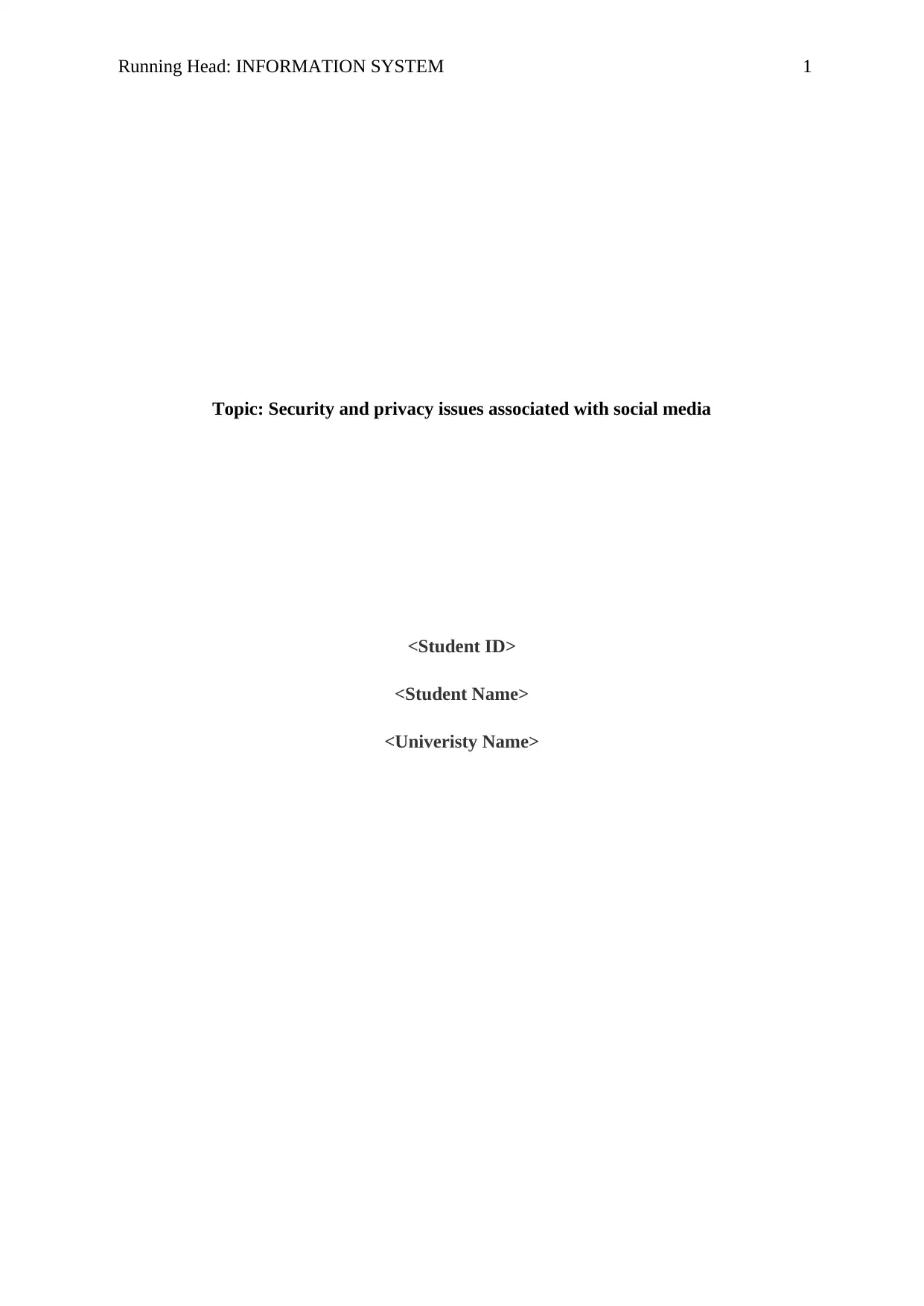
Running Head: INFORMATION SYSTEM 1
Topic: Security and privacy issues associated with social media
<Student ID>
<Student Name>
<Univeristy Name>
Topic: Security and privacy issues associated with social media
<Student ID>
<Student Name>
<Univeristy Name>
Paraphrase This Document
Need a fresh take? Get an instant paraphrase of this document with our AI Paraphraser
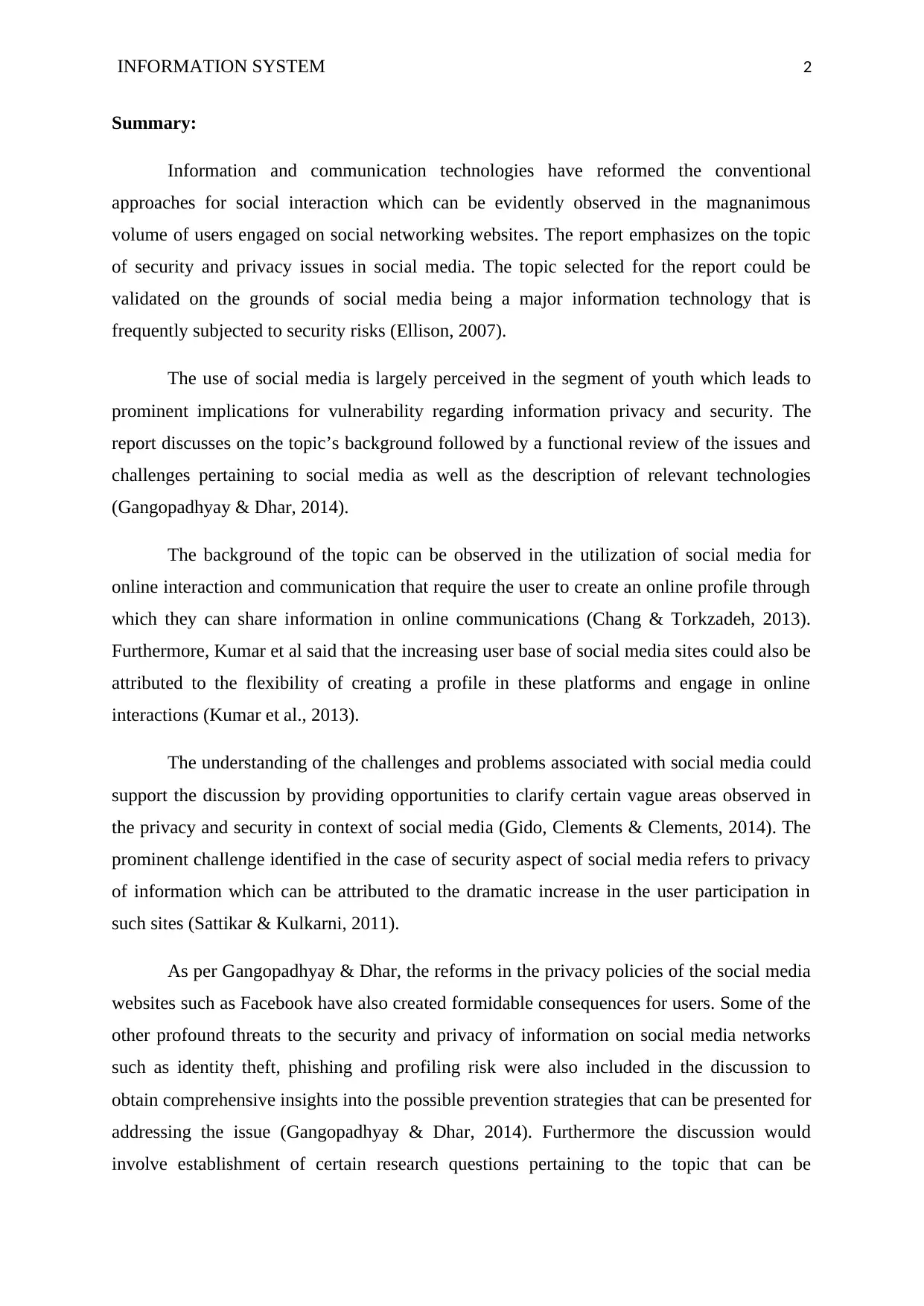
INFORMATION SYSTEM 2
Summary:
Information and communication technologies have reformed the conventional
approaches for social interaction which can be evidently observed in the magnanimous
volume of users engaged on social networking websites. The report emphasizes on the topic
of security and privacy issues in social media. The topic selected for the report could be
validated on the grounds of social media being a major information technology that is
frequently subjected to security risks (Ellison, 2007).
The use of social media is largely perceived in the segment of youth which leads to
prominent implications for vulnerability regarding information privacy and security. The
report discusses on the topic’s background followed by a functional review of the issues and
challenges pertaining to social media as well as the description of relevant technologies
(Gangopadhyay & Dhar, 2014).
The background of the topic can be observed in the utilization of social media for
online interaction and communication that require the user to create an online profile through
which they can share information in online communications (Chang & Torkzadeh, 2013).
Furthermore, Kumar et al said that the increasing user base of social media sites could also be
attributed to the flexibility of creating a profile in these platforms and engage in online
interactions (Kumar et al., 2013).
The understanding of the challenges and problems associated with social media could
support the discussion by providing opportunities to clarify certain vague areas observed in
the privacy and security in context of social media (Gido, Clements & Clements, 2014). The
prominent challenge identified in the case of security aspect of social media refers to privacy
of information which can be attributed to the dramatic increase in the user participation in
such sites (Sattikar & Kulkarni, 2011).
As per Gangopadhyay & Dhar, the reforms in the privacy policies of the social media
websites such as Facebook have also created formidable consequences for users. Some of the
other profound threats to the security and privacy of information on social media networks
such as identity theft, phishing and profiling risk were also included in the discussion to
obtain comprehensive insights into the possible prevention strategies that can be presented for
addressing the issue (Gangopadhyay & Dhar, 2014). Furthermore the discussion would
involve establishment of certain research questions pertaining to the topic that can be
Summary:
Information and communication technologies have reformed the conventional
approaches for social interaction which can be evidently observed in the magnanimous
volume of users engaged on social networking websites. The report emphasizes on the topic
of security and privacy issues in social media. The topic selected for the report could be
validated on the grounds of social media being a major information technology that is
frequently subjected to security risks (Ellison, 2007).
The use of social media is largely perceived in the segment of youth which leads to
prominent implications for vulnerability regarding information privacy and security. The
report discusses on the topic’s background followed by a functional review of the issues and
challenges pertaining to social media as well as the description of relevant technologies
(Gangopadhyay & Dhar, 2014).
The background of the topic can be observed in the utilization of social media for
online interaction and communication that require the user to create an online profile through
which they can share information in online communications (Chang & Torkzadeh, 2013).
Furthermore, Kumar et al said that the increasing user base of social media sites could also be
attributed to the flexibility of creating a profile in these platforms and engage in online
interactions (Kumar et al., 2013).
The understanding of the challenges and problems associated with social media could
support the discussion by providing opportunities to clarify certain vague areas observed in
the privacy and security in context of social media (Gido, Clements & Clements, 2014). The
prominent challenge identified in the case of security aspect of social media refers to privacy
of information which can be attributed to the dramatic increase in the user participation in
such sites (Sattikar & Kulkarni, 2011).
As per Gangopadhyay & Dhar, the reforms in the privacy policies of the social media
websites such as Facebook have also created formidable consequences for users. Some of the
other profound threats to the security and privacy of information on social media networks
such as identity theft, phishing and profiling risk were also included in the discussion to
obtain comprehensive insights into the possible prevention strategies that can be presented for
addressing the issue (Gangopadhyay & Dhar, 2014). Furthermore the discussion would
involve establishment of certain research questions pertaining to the topic that can be
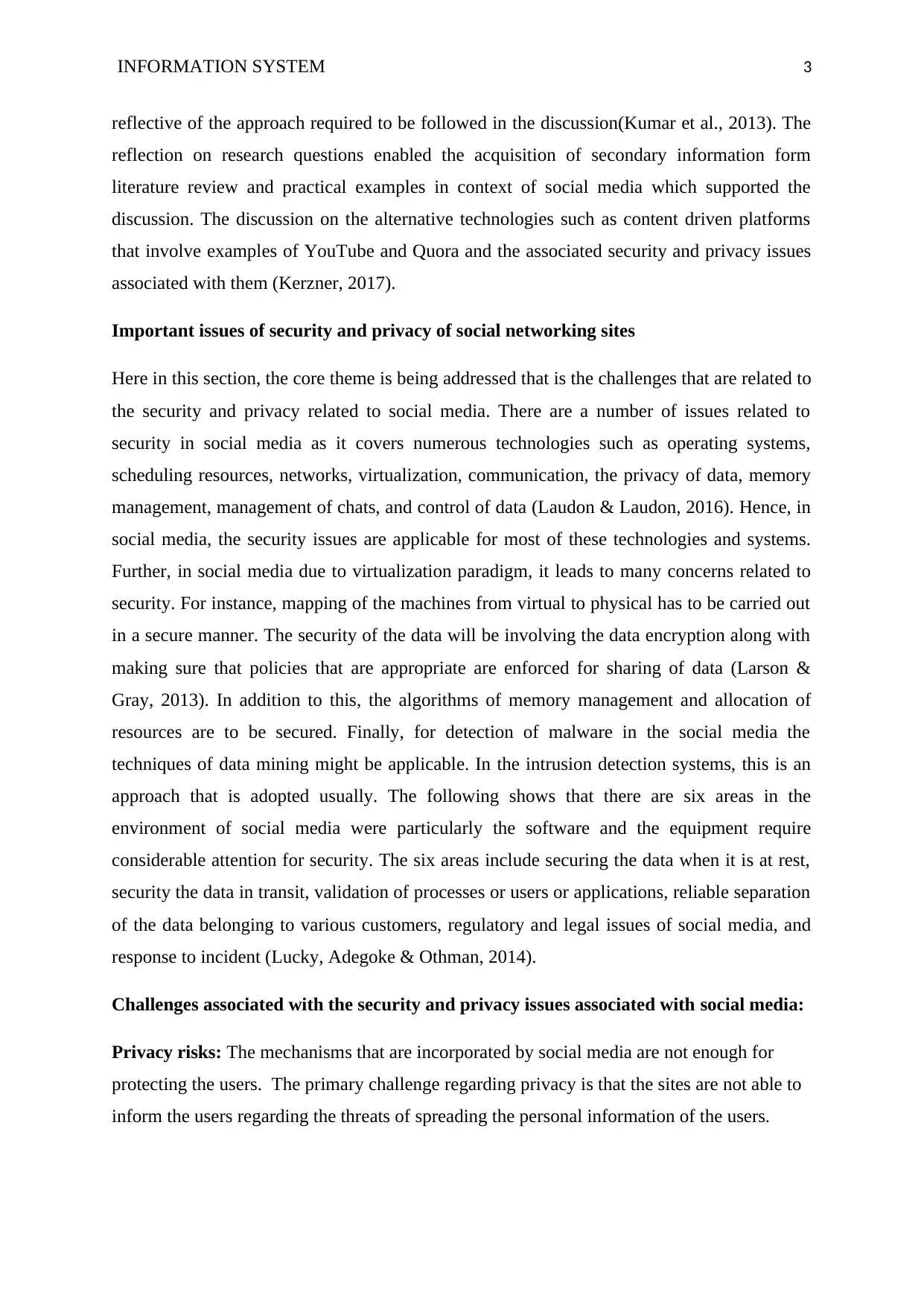
INFORMATION SYSTEM 3
reflective of the approach required to be followed in the discussion(Kumar et al., 2013). The
reflection on research questions enabled the acquisition of secondary information form
literature review and practical examples in context of social media which supported the
discussion. The discussion on the alternative technologies such as content driven platforms
that involve examples of YouTube and Quora and the associated security and privacy issues
associated with them (Kerzner, 2017).
Important issues of security and privacy of social networking sites
Here in this section, the core theme is being addressed that is the challenges that are related to
the security and privacy related to social media. There are a number of issues related to
security in social media as it covers numerous technologies such as operating systems,
scheduling resources, networks, virtualization, communication, the privacy of data, memory
management, management of chats, and control of data (Laudon & Laudon, 2016). Hence, in
social media, the security issues are applicable for most of these technologies and systems.
Further, in social media due to virtualization paradigm, it leads to many concerns related to
security. For instance, mapping of the machines from virtual to physical has to be carried out
in a secure manner. The security of the data will be involving the data encryption along with
making sure that policies that are appropriate are enforced for sharing of data (Larson &
Gray, 2013). In addition to this, the algorithms of memory management and allocation of
resources are to be secured. Finally, for detection of malware in the social media the
techniques of data mining might be applicable. In the intrusion detection systems, this is an
approach that is adopted usually. The following shows that there are six areas in the
environment of social media were particularly the software and the equipment require
considerable attention for security. The six areas include securing the data when it is at rest,
security the data in transit, validation of processes or users or applications, reliable separation
of the data belonging to various customers, regulatory and legal issues of social media, and
response to incident (Lucky, Adegoke & Othman, 2014).
Challenges associated with the security and privacy issues associated with social media:
Privacy risks: The mechanisms that are incorporated by social media are not enough for
protecting the users. The primary challenge regarding privacy is that the sites are not able to
inform the users regarding the threats of spreading the personal information of the users.
reflective of the approach required to be followed in the discussion(Kumar et al., 2013). The
reflection on research questions enabled the acquisition of secondary information form
literature review and practical examples in context of social media which supported the
discussion. The discussion on the alternative technologies such as content driven platforms
that involve examples of YouTube and Quora and the associated security and privacy issues
associated with them (Kerzner, 2017).
Important issues of security and privacy of social networking sites
Here in this section, the core theme is being addressed that is the challenges that are related to
the security and privacy related to social media. There are a number of issues related to
security in social media as it covers numerous technologies such as operating systems,
scheduling resources, networks, virtualization, communication, the privacy of data, memory
management, management of chats, and control of data (Laudon & Laudon, 2016). Hence, in
social media, the security issues are applicable for most of these technologies and systems.
Further, in social media due to virtualization paradigm, it leads to many concerns related to
security. For instance, mapping of the machines from virtual to physical has to be carried out
in a secure manner. The security of the data will be involving the data encryption along with
making sure that policies that are appropriate are enforced for sharing of data (Larson &
Gray, 2013). In addition to this, the algorithms of memory management and allocation of
resources are to be secured. Finally, for detection of malware in the social media the
techniques of data mining might be applicable. In the intrusion detection systems, this is an
approach that is adopted usually. The following shows that there are six areas in the
environment of social media were particularly the software and the equipment require
considerable attention for security. The six areas include securing the data when it is at rest,
security the data in transit, validation of processes or users or applications, reliable separation
of the data belonging to various customers, regulatory and legal issues of social media, and
response to incident (Lucky, Adegoke & Othman, 2014).
Challenges associated with the security and privacy issues associated with social media:
Privacy risks: The mechanisms that are incorporated by social media are not enough for
protecting the users. The primary challenge regarding privacy is that the sites are not able to
inform the users regarding the threats of spreading the personal information of the users.
⊘ This is a preview!⊘
Do you want full access?
Subscribe today to unlock all pages.

Trusted by 1+ million students worldwide
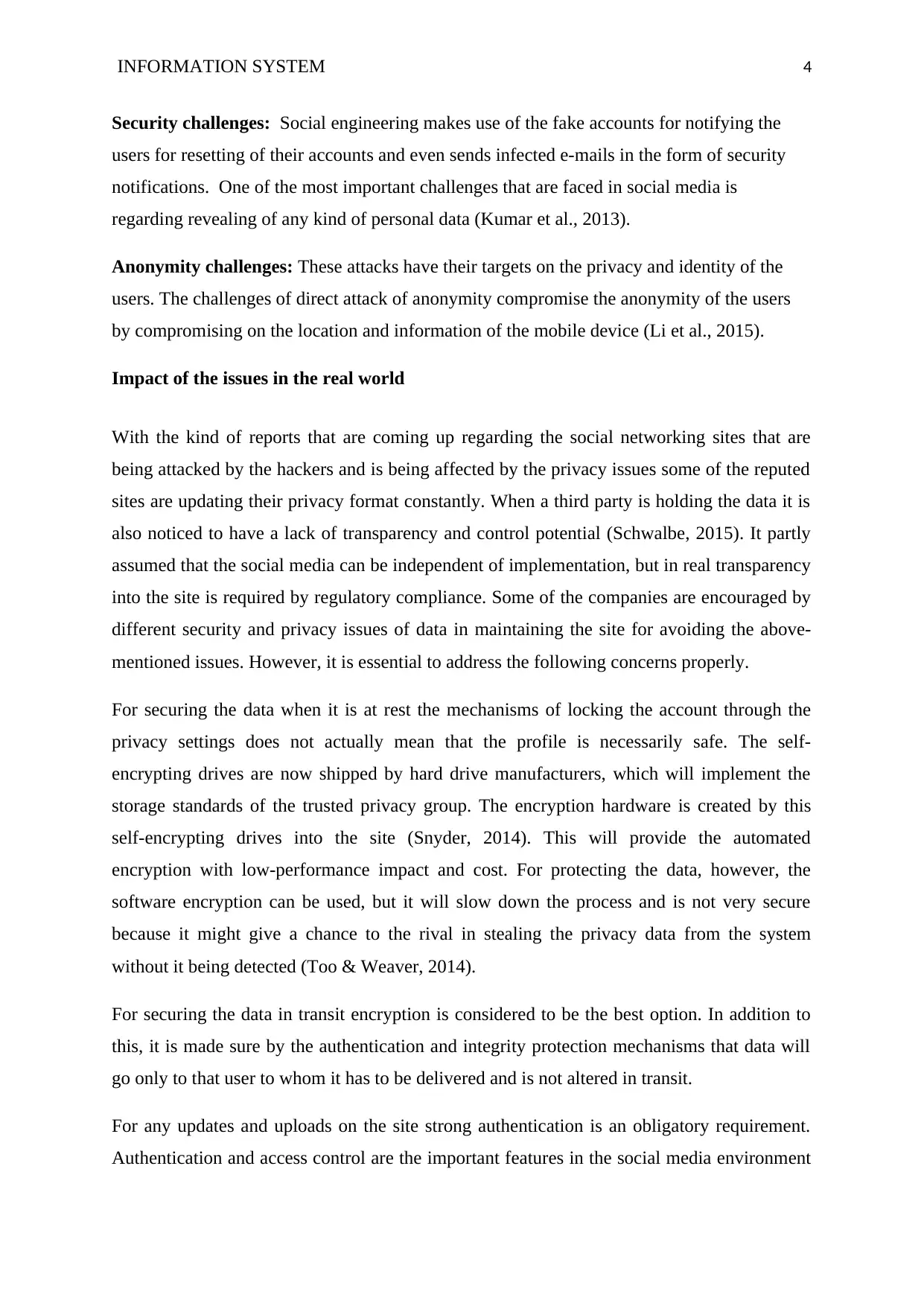
INFORMATION SYSTEM 4
Security challenges: Social engineering makes use of the fake accounts for notifying the
users for resetting of their accounts and even sends infected e-mails in the form of security
notifications. One of the most important challenges that are faced in social media is
regarding revealing of any kind of personal data (Kumar et al., 2013).
Anonymity challenges: These attacks have their targets on the privacy and identity of the
users. The challenges of direct attack of anonymity compromise the anonymity of the users
by compromising on the location and information of the mobile device (Li et al., 2015).
Impact of the issues in the real world
With the kind of reports that are coming up regarding the social networking sites that are
being attacked by the hackers and is being affected by the privacy issues some of the reputed
sites are updating their privacy format constantly. When a third party is holding the data it is
also noticed to have a lack of transparency and control potential (Schwalbe, 2015). It partly
assumed that the social media can be independent of implementation, but in real transparency
into the site is required by regulatory compliance. Some of the companies are encouraged by
different security and privacy issues of data in maintaining the site for avoiding the above-
mentioned issues. However, it is essential to address the following concerns properly.
For securing the data when it is at rest the mechanisms of locking the account through the
privacy settings does not actually mean that the profile is necessarily safe. The self-
encrypting drives are now shipped by hard drive manufacturers, which will implement the
storage standards of the trusted privacy group. The encryption hardware is created by this
self-encrypting drives into the site (Snyder, 2014). This will provide the automated
encryption with low-performance impact and cost. For protecting the data, however, the
software encryption can be used, but it will slow down the process and is not very secure
because it might give a chance to the rival in stealing the privacy data from the system
without it being detected (Too & Weaver, 2014).
For securing the data in transit encryption is considered to be the best option. In addition to
this, it is made sure by the authentication and integrity protection mechanisms that data will
go only to that user to whom it has to be delivered and is not altered in transit.
For any updates and uploads on the site strong authentication is an obligatory requirement.
Authentication and access control are the important features in the social media environment
Security challenges: Social engineering makes use of the fake accounts for notifying the
users for resetting of their accounts and even sends infected e-mails in the form of security
notifications. One of the most important challenges that are faced in social media is
regarding revealing of any kind of personal data (Kumar et al., 2013).
Anonymity challenges: These attacks have their targets on the privacy and identity of the
users. The challenges of direct attack of anonymity compromise the anonymity of the users
by compromising on the location and information of the mobile device (Li et al., 2015).
Impact of the issues in the real world
With the kind of reports that are coming up regarding the social networking sites that are
being attacked by the hackers and is being affected by the privacy issues some of the reputed
sites are updating their privacy format constantly. When a third party is holding the data it is
also noticed to have a lack of transparency and control potential (Schwalbe, 2015). It partly
assumed that the social media can be independent of implementation, but in real transparency
into the site is required by regulatory compliance. Some of the companies are encouraged by
different security and privacy issues of data in maintaining the site for avoiding the above-
mentioned issues. However, it is essential to address the following concerns properly.
For securing the data when it is at rest the mechanisms of locking the account through the
privacy settings does not actually mean that the profile is necessarily safe. The self-
encrypting drives are now shipped by hard drive manufacturers, which will implement the
storage standards of the trusted privacy group. The encryption hardware is created by this
self-encrypting drives into the site (Snyder, 2014). This will provide the automated
encryption with low-performance impact and cost. For protecting the data, however, the
software encryption can be used, but it will slow down the process and is not very secure
because it might give a chance to the rival in stealing the privacy data from the system
without it being detected (Too & Weaver, 2014).
For securing the data in transit encryption is considered to be the best option. In addition to
this, it is made sure by the authentication and integrity protection mechanisms that data will
go only to that user to whom it has to be delivered and is not altered in transit.
For any updates and uploads on the site strong authentication is an obligatory requirement.
Authentication and access control are the important features in the social media environment
Paraphrase This Document
Need a fresh take? Get an instant paraphrase of this document with our AI Paraphraser
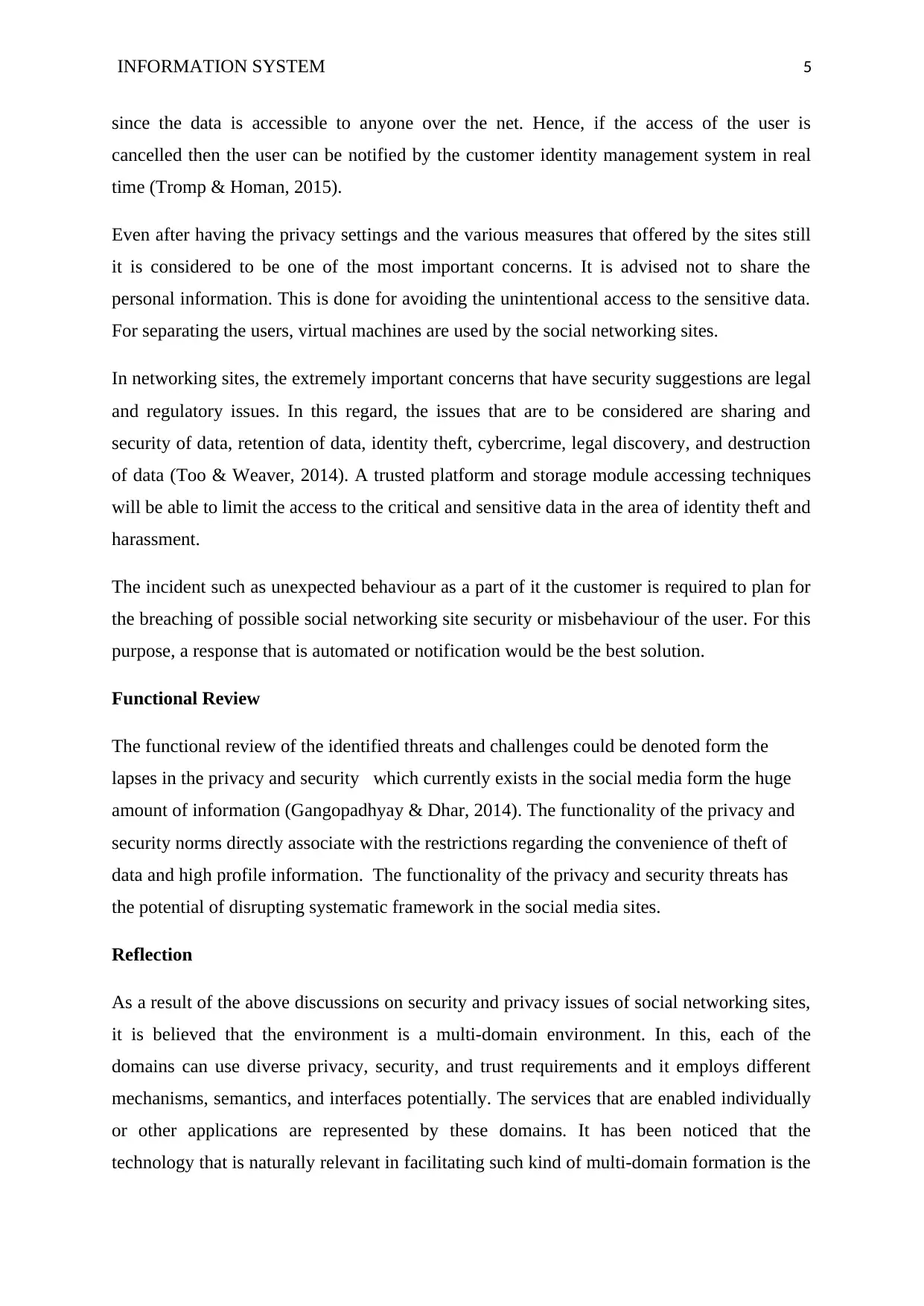
INFORMATION SYSTEM 5
since the data is accessible to anyone over the net. Hence, if the access of the user is
cancelled then the user can be notified by the customer identity management system in real
time (Tromp & Homan, 2015).
Even after having the privacy settings and the various measures that offered by the sites still
it is considered to be one of the most important concerns. It is advised not to share the
personal information. This is done for avoiding the unintentional access to the sensitive data.
For separating the users, virtual machines are used by the social networking sites.
In networking sites, the extremely important concerns that have security suggestions are legal
and regulatory issues. In this regard, the issues that are to be considered are sharing and
security of data, retention of data, identity theft, cybercrime, legal discovery, and destruction
of data (Too & Weaver, 2014). A trusted platform and storage module accessing techniques
will be able to limit the access to the critical and sensitive data in the area of identity theft and
harassment.
The incident such as unexpected behaviour as a part of it the customer is required to plan for
the breaching of possible social networking site security or misbehaviour of the user. For this
purpose, a response that is automated or notification would be the best solution.
Functional Review
The functional review of the identified threats and challenges could be denoted form the
lapses in the privacy and security which currently exists in the social media form the huge
amount of information (Gangopadhyay & Dhar, 2014). The functionality of the privacy and
security norms directly associate with the restrictions regarding the convenience of theft of
data and high profile information. The functionality of the privacy and security threats has
the potential of disrupting systematic framework in the social media sites.
Reflection
As a result of the above discussions on security and privacy issues of social networking sites,
it is believed that the environment is a multi-domain environment. In this, each of the
domains can use diverse privacy, security, and trust requirements and it employs different
mechanisms, semantics, and interfaces potentially. The services that are enabled individually
or other applications are represented by these domains. It has been noticed that the
technology that is naturally relevant in facilitating such kind of multi-domain formation is the
since the data is accessible to anyone over the net. Hence, if the access of the user is
cancelled then the user can be notified by the customer identity management system in real
time (Tromp & Homan, 2015).
Even after having the privacy settings and the various measures that offered by the sites still
it is considered to be one of the most important concerns. It is advised not to share the
personal information. This is done for avoiding the unintentional access to the sensitive data.
For separating the users, virtual machines are used by the social networking sites.
In networking sites, the extremely important concerns that have security suggestions are legal
and regulatory issues. In this regard, the issues that are to be considered are sharing and
security of data, retention of data, identity theft, cybercrime, legal discovery, and destruction
of data (Too & Weaver, 2014). A trusted platform and storage module accessing techniques
will be able to limit the access to the critical and sensitive data in the area of identity theft and
harassment.
The incident such as unexpected behaviour as a part of it the customer is required to plan for
the breaching of possible social networking site security or misbehaviour of the user. For this
purpose, a response that is automated or notification would be the best solution.
Functional Review
The functional review of the identified threats and challenges could be denoted form the
lapses in the privacy and security which currently exists in the social media form the huge
amount of information (Gangopadhyay & Dhar, 2014). The functionality of the privacy and
security norms directly associate with the restrictions regarding the convenience of theft of
data and high profile information. The functionality of the privacy and security threats has
the potential of disrupting systematic framework in the social media sites.
Reflection
As a result of the above discussions on security and privacy issues of social networking sites,
it is believed that the environment is a multi-domain environment. In this, each of the
domains can use diverse privacy, security, and trust requirements and it employs different
mechanisms, semantics, and interfaces potentially. The services that are enabled individually
or other applications are represented by these domains. It has been noticed that the
technology that is naturally relevant in facilitating such kind of multi-domain formation is the
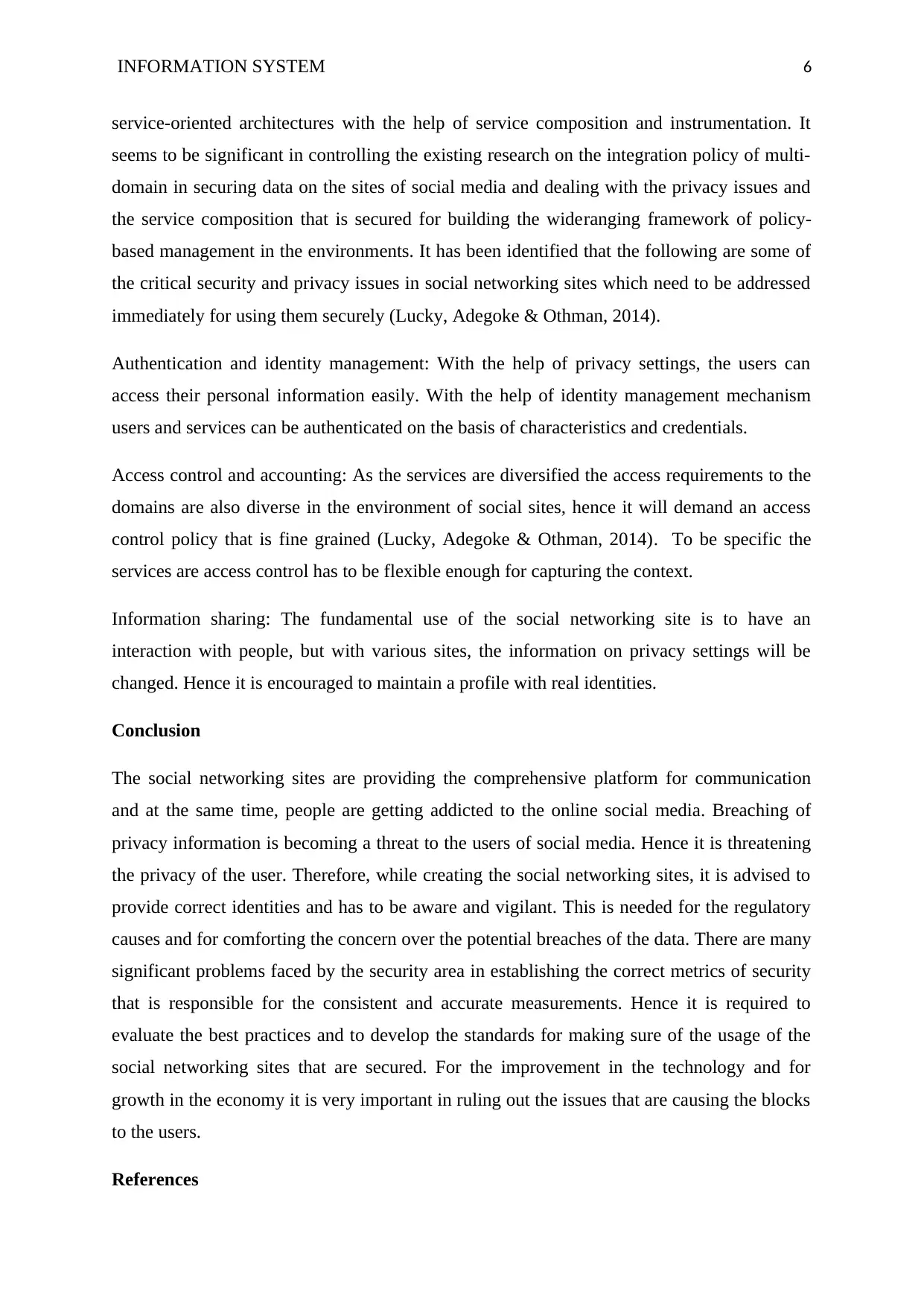
INFORMATION SYSTEM 6
service-oriented architectures with the help of service composition and instrumentation. It
seems to be significant in controlling the existing research on the integration policy of multi-
domain in securing data on the sites of social media and dealing with the privacy issues and
the service composition that is secured for building the wideranging framework of policy-
based management in the environments. It has been identified that the following are some of
the critical security and privacy issues in social networking sites which need to be addressed
immediately for using them securely (Lucky, Adegoke & Othman, 2014).
Authentication and identity management: With the help of privacy settings, the users can
access their personal information easily. With the help of identity management mechanism
users and services can be authenticated on the basis of characteristics and credentials.
Access control and accounting: As the services are diversified the access requirements to the
domains are also diverse in the environment of social sites, hence it will demand an access
control policy that is fine grained (Lucky, Adegoke & Othman, 2014). To be specific the
services are access control has to be flexible enough for capturing the context.
Information sharing: The fundamental use of the social networking site is to have an
interaction with people, but with various sites, the information on privacy settings will be
changed. Hence it is encouraged to maintain a profile with real identities.
Conclusion
The social networking sites are providing the comprehensive platform for communication
and at the same time, people are getting addicted to the online social media. Breaching of
privacy information is becoming a threat to the users of social media. Hence it is threatening
the privacy of the user. Therefore, while creating the social networking sites, it is advised to
provide correct identities and has to be aware and vigilant. This is needed for the regulatory
causes and for comforting the concern over the potential breaches of the data. There are many
significant problems faced by the security area in establishing the correct metrics of security
that is responsible for the consistent and accurate measurements. Hence it is required to
evaluate the best practices and to develop the standards for making sure of the usage of the
social networking sites that are secured. For the improvement in the technology and for
growth in the economy it is very important in ruling out the issues that are causing the blocks
to the users.
References
service-oriented architectures with the help of service composition and instrumentation. It
seems to be significant in controlling the existing research on the integration policy of multi-
domain in securing data on the sites of social media and dealing with the privacy issues and
the service composition that is secured for building the wideranging framework of policy-
based management in the environments. It has been identified that the following are some of
the critical security and privacy issues in social networking sites which need to be addressed
immediately for using them securely (Lucky, Adegoke & Othman, 2014).
Authentication and identity management: With the help of privacy settings, the users can
access their personal information easily. With the help of identity management mechanism
users and services can be authenticated on the basis of characteristics and credentials.
Access control and accounting: As the services are diversified the access requirements to the
domains are also diverse in the environment of social sites, hence it will demand an access
control policy that is fine grained (Lucky, Adegoke & Othman, 2014). To be specific the
services are access control has to be flexible enough for capturing the context.
Information sharing: The fundamental use of the social networking site is to have an
interaction with people, but with various sites, the information on privacy settings will be
changed. Hence it is encouraged to maintain a profile with real identities.
Conclusion
The social networking sites are providing the comprehensive platform for communication
and at the same time, people are getting addicted to the online social media. Breaching of
privacy information is becoming a threat to the users of social media. Hence it is threatening
the privacy of the user. Therefore, while creating the social networking sites, it is advised to
provide correct identities and has to be aware and vigilant. This is needed for the regulatory
causes and for comforting the concern over the potential breaches of the data. There are many
significant problems faced by the security area in establishing the correct metrics of security
that is responsible for the consistent and accurate measurements. Hence it is required to
evaluate the best practices and to develop the standards for making sure of the usage of the
social networking sites that are secured. For the improvement in the technology and for
growth in the economy it is very important in ruling out the issues that are causing the blocks
to the users.
References
⊘ This is a preview!⊘
Do you want full access?
Subscribe today to unlock all pages.

Trusted by 1+ million students worldwide
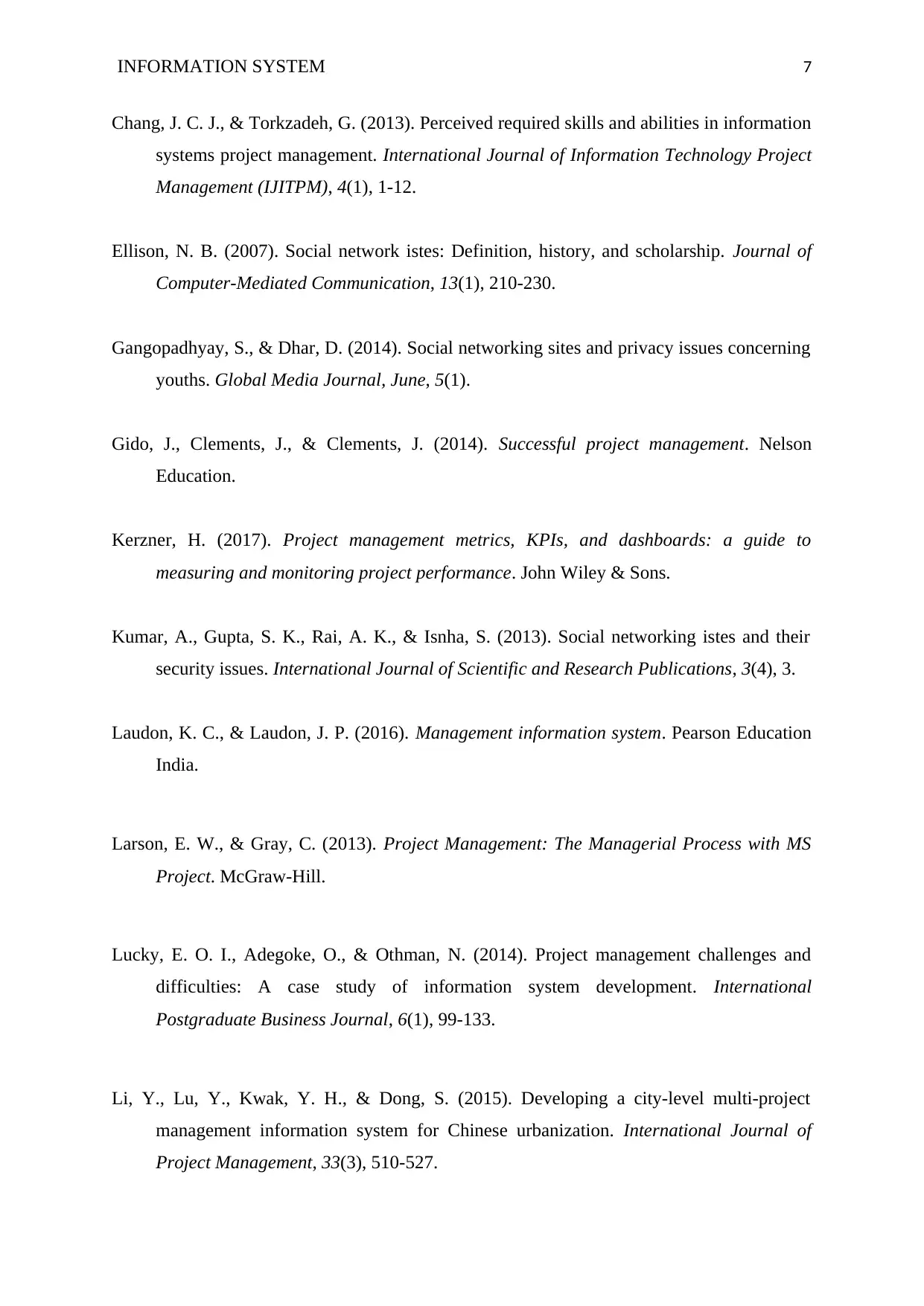
INFORMATION SYSTEM 7
Chang, J. C. J., & Torkzadeh, G. (2013). Perceived required skills and abilities in information
systems project management. International Journal of Information Technology Project
Management (IJITPM), 4(1), 1-12.
Ellison, N. B. (2007). Social network istes: Definition, history, and scholarship. Journal of
Computer‐Mediated Communication, 13(1), 210-230.
Gangopadhyay, S., & Dhar, D. (2014). Social networking sites and privacy issues concerning
youths. Global Media Journal, June, 5(1).
Gido, J., Clements, J., & Clements, J. (2014). Successful project management. Nelson
Education.
Kerzner, H. (2017). Project management metrics, KPIs, and dashboards: a guide to
measuring and monitoring project performance. John Wiley & Sons.
Kumar, A., Gupta, S. K., Rai, A. K., & Isnha, S. (2013). Social networking istes and their
security issues. International Journal of Scientific and Research Publications, 3(4), 3.
Laudon, K. C., & Laudon, J. P. (2016). Management information system. Pearson Education
India.
Larson, E. W., & Gray, C. (2013). Project Management: The Managerial Process with MS
Project. McGraw-Hill.
Lucky, E. O. I., Adegoke, O., & Othman, N. (2014). Project management challenges and
difficulties: A case study of information system development. International
Postgraduate Business Journal, 6(1), 99-133.
Li, Y., Lu, Y., Kwak, Y. H., & Dong, S. (2015). Developing a city-level multi-project
management information system for Chinese urbanization. International Journal of
Project Management, 33(3), 510-527.
Chang, J. C. J., & Torkzadeh, G. (2013). Perceived required skills and abilities in information
systems project management. International Journal of Information Technology Project
Management (IJITPM), 4(1), 1-12.
Ellison, N. B. (2007). Social network istes: Definition, history, and scholarship. Journal of
Computer‐Mediated Communication, 13(1), 210-230.
Gangopadhyay, S., & Dhar, D. (2014). Social networking sites and privacy issues concerning
youths. Global Media Journal, June, 5(1).
Gido, J., Clements, J., & Clements, J. (2014). Successful project management. Nelson
Education.
Kerzner, H. (2017). Project management metrics, KPIs, and dashboards: a guide to
measuring and monitoring project performance. John Wiley & Sons.
Kumar, A., Gupta, S. K., Rai, A. K., & Isnha, S. (2013). Social networking istes and their
security issues. International Journal of Scientific and Research Publications, 3(4), 3.
Laudon, K. C., & Laudon, J. P. (2016). Management information system. Pearson Education
India.
Larson, E. W., & Gray, C. (2013). Project Management: The Managerial Process with MS
Project. McGraw-Hill.
Lucky, E. O. I., Adegoke, O., & Othman, N. (2014). Project management challenges and
difficulties: A case study of information system development. International
Postgraduate Business Journal, 6(1), 99-133.
Li, Y., Lu, Y., Kwak, Y. H., & Dong, S. (2015). Developing a city-level multi-project
management information system for Chinese urbanization. International Journal of
Project Management, 33(3), 510-527.
Paraphrase This Document
Need a fresh take? Get an instant paraphrase of this document with our AI Paraphraser
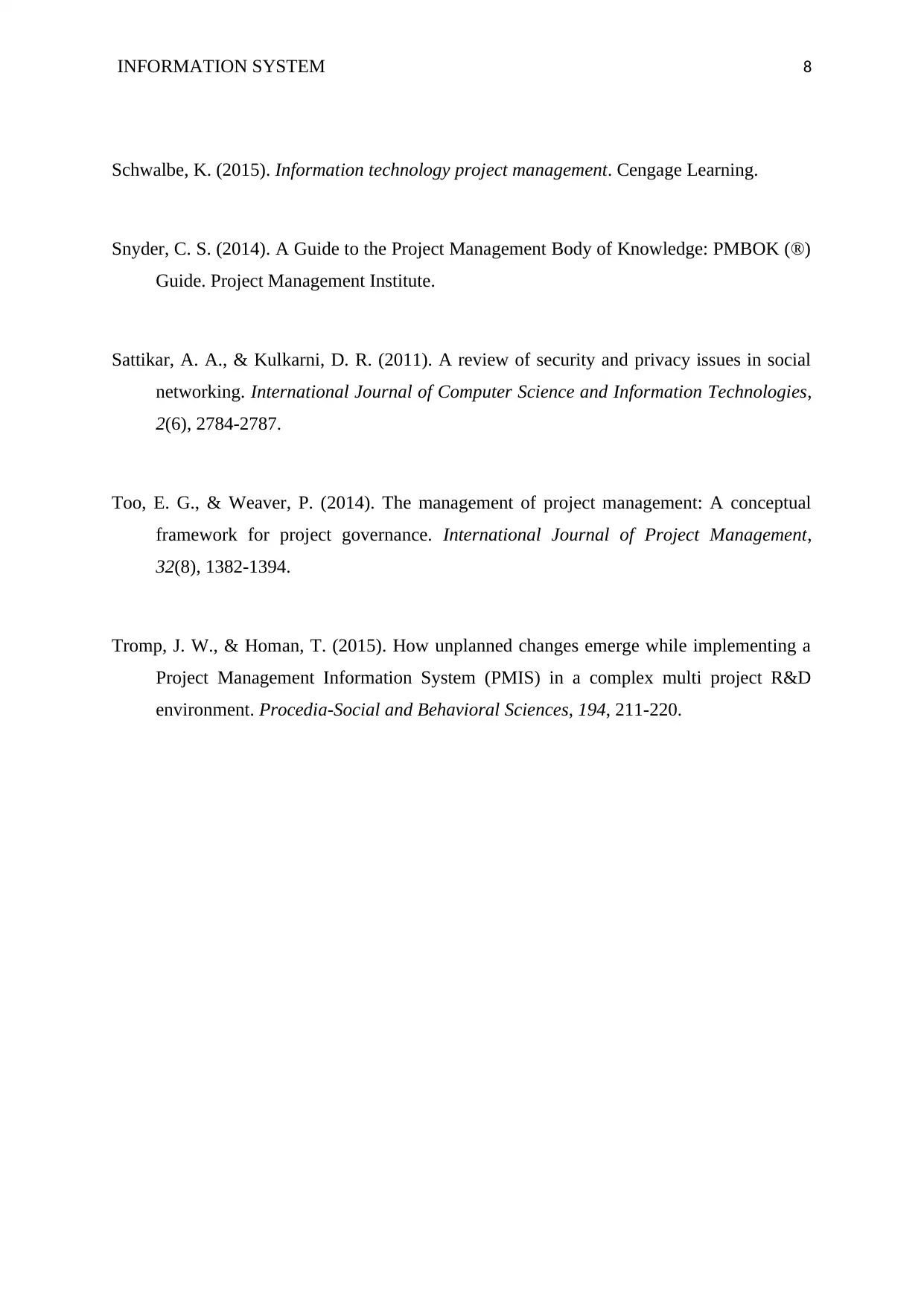
INFORMATION SYSTEM 8
Schwalbe, K. (2015). Information technology project management. Cengage Learning.
Snyder, C. S. (2014). A Guide to the Project Management Body of Knowledge: PMBOK (®)
Guide. Project Management Institute.
Sattikar, A. A., & Kulkarni, D. R. (2011). A review of security and privacy issues in social
networking. International Journal of Computer Science and Information Technologies,
2(6), 2784-2787.
Too, E. G., & Weaver, P. (2014). The management of project management: A conceptual
framework for project governance. International Journal of Project Management,
32(8), 1382-1394.
Tromp, J. W., & Homan, T. (2015). How unplanned changes emerge while implementing a
Project Management Information System (PMIS) in a complex multi project R&D
environment. Procedia-Social and Behavioral Sciences, 194, 211-220.
Schwalbe, K. (2015). Information technology project management. Cengage Learning.
Snyder, C. S. (2014). A Guide to the Project Management Body of Knowledge: PMBOK (®)
Guide. Project Management Institute.
Sattikar, A. A., & Kulkarni, D. R. (2011). A review of security and privacy issues in social
networking. International Journal of Computer Science and Information Technologies,
2(6), 2784-2787.
Too, E. G., & Weaver, P. (2014). The management of project management: A conceptual
framework for project governance. International Journal of Project Management,
32(8), 1382-1394.
Tromp, J. W., & Homan, T. (2015). How unplanned changes emerge while implementing a
Project Management Information System (PMIS) in a complex multi project R&D
environment. Procedia-Social and Behavioral Sciences, 194, 211-220.
1 out of 8
Related Documents
Your All-in-One AI-Powered Toolkit for Academic Success.
+13062052269
info@desklib.com
Available 24*7 on WhatsApp / Email
![[object Object]](/_next/static/media/star-bottom.7253800d.svg)
Unlock your academic potential
Copyright © 2020–2025 A2Z Services. All Rights Reserved. Developed and managed by ZUCOL.





